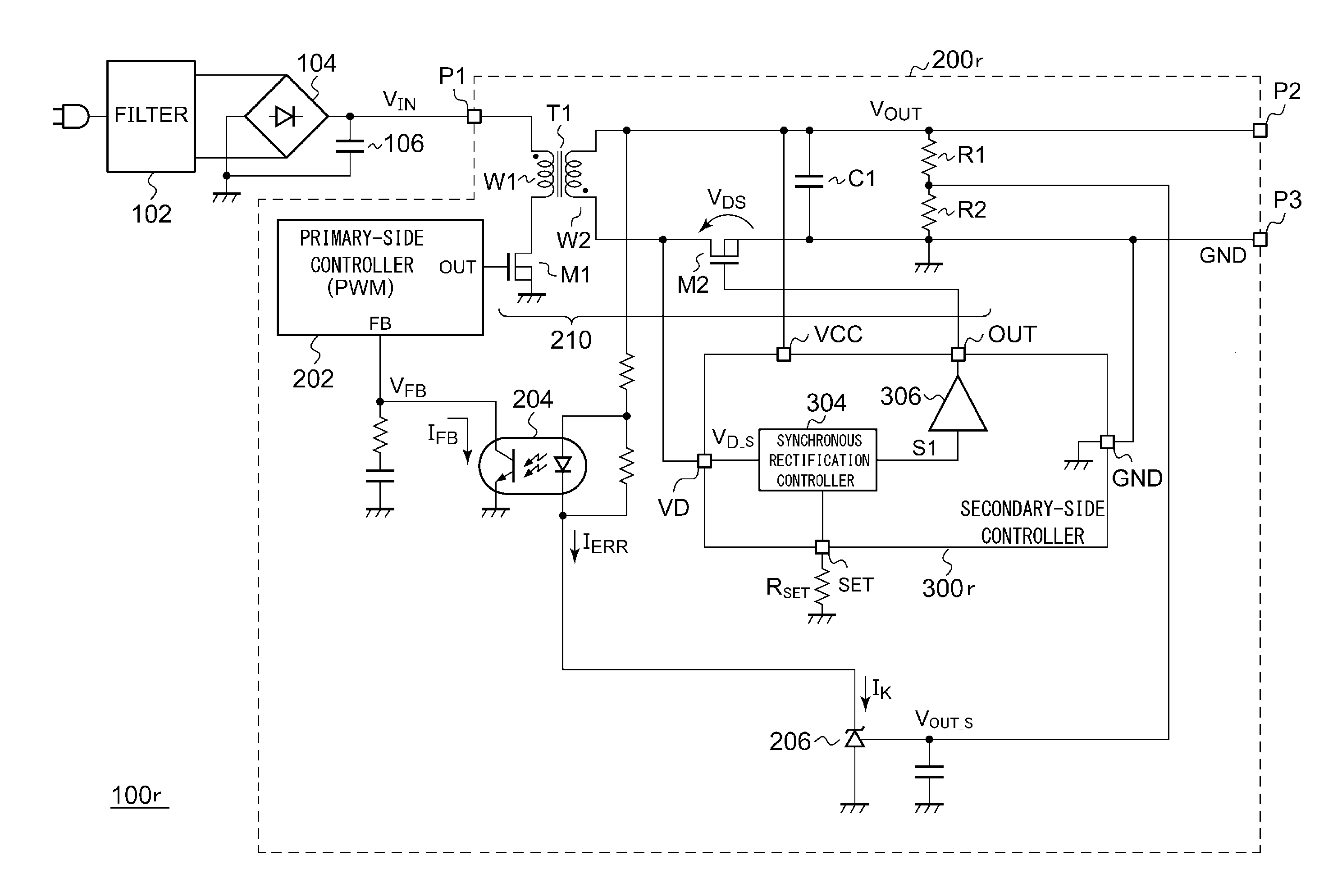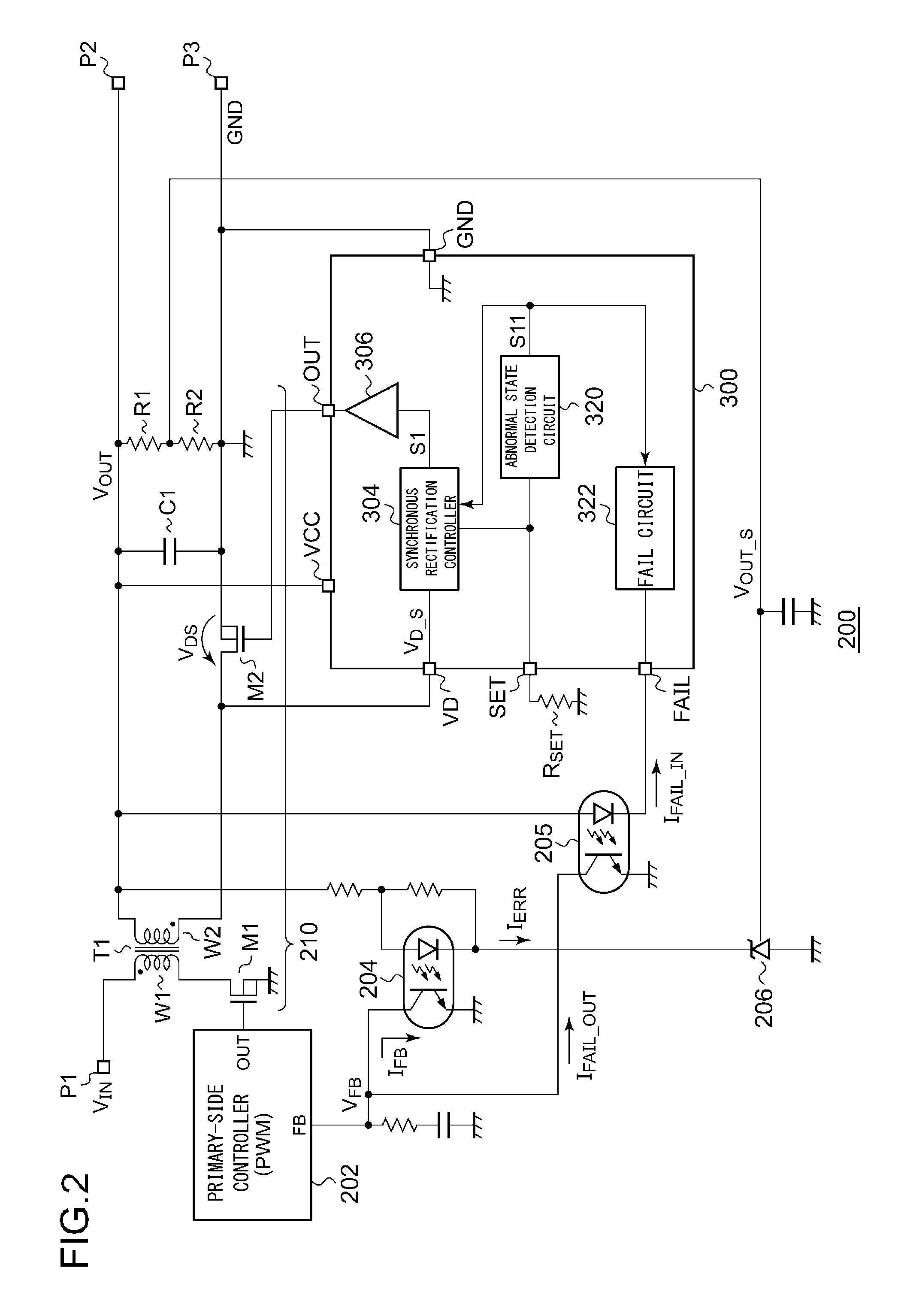Insulated synchronous rectification dc/dc converter
a synchronous rectification and converter technology, applied in the direction of dc-dc conversion, climate sustainability, power conversion systems, etc., can solve the problems of abnormal operation of synchronous rectification transistors, inability to measure control time with high precision, etc., and achieve the effect of uniform characteristics and reduced circuit area
- Summary
- Abstract
- Description
- Claims
- Application Information
AI Technical Summary
Benefits of technology
Problems solved by technology
Method used
Image
Examples
first embodiment
[0083]FIG. 2 is a circuit diagram showing a DC / DC converter 200 including a secondary-side controller 300 according to a first embodiment. The DC / DC converter 200 is applicable to the AC / DC converter in the same way as with the DC / DC converter 200r shown in FIG. 1. Also, the DC / DC converter 200 has the same basic configuration as that of the DC / DC converter 200r shown in FIG. 1.
[0084]The secondary-side controller 300 includes a power supply (VCC) terminal, a switching output (OUT) terminal, a drain (VD) terminal, and a ground (GND) terminal. The secondary-side controller 300 is configured as a function IC (Integrated Circuit) integrally formed on a single semiconductor substrate. The secondary-side controller 300 is housed in a single package together with the synchronous rectification transistor M2. That is to say, the secondary-side controller 300 and the synchronous rectification transistor M2 are monolithically integrated as a single module.
[0085]A DC voltage (here, the output v...
second embodiment
[0110]FIG. 5 is a DC / DC converter 200c including a secondary-side controller 300c according to a second embodiment. The secondary-side controller 300c has the same configuration as that of the secondary-side controller 300 shown in FIG. 2 except that a shunt regulator 206 is built into the secondary-side controller 300c. The shunt regulator 206 includes a transistor M3 and an error amplifier 207. The voltage detection signal VOUT_S is input to the input terminal (SH_IN) of the shunt regulator 206. The error amplifier 207 amplifies the difference between the voltage detection signal VOUT_S and the reference voltage VREF. The transistor M3 is connected to the output terminal (SH_OUT) of the shunt regulator 206. The output VERR of the error amplifier 207 is input to the gate of the transistor M3. In a case in which the transistor M3 is configured as a P-channel MOSFET or otherwise a PNP bipolar transistor, the error amplifier 207 may preferably be arranged such that its inverting input...
third embodiment
[0112]FIG. 6 is a circuit diagram showing a DC / DC converter 200d including a secondary-side controller 300d according to a third embodiment. A shunt regulator 206 is built into the secondary-side controller 300d, as with a configuration shown in FIG. 5. When the detection signal S11 is asserted, a fail circuit 322d drives the feedback photocoupler 204 connected to the SH_OUT terminal.
[0113]For the secondary-side controller 300d, it can be understood that the SH_OUT terminal also provides the same effect as that provided by the FAIL terminal, and that the feedback photocoupler 204 provides the same effect as that provided by the fail notification photocoupler 205.
[0114]Next, description will be made regarding a specific example configuration of the secondary-side controller 300. It should be noted that the present invention encompasses various arrangements derived based on the first through third embodiments. That is to say, the present invention is not restricted to such a specific ...
PUM
 Login to View More
Login to View More Abstract
Description
Claims
Application Information
 Login to View More
Login to View More - R&D
- Intellectual Property
- Life Sciences
- Materials
- Tech Scout
- Unparalleled Data Quality
- Higher Quality Content
- 60% Fewer Hallucinations
Browse by: Latest US Patents, China's latest patents, Technical Efficacy Thesaurus, Application Domain, Technology Topic, Popular Technical Reports.
© 2025 PatSnap. All rights reserved.Legal|Privacy policy|Modern Slavery Act Transparency Statement|Sitemap|About US| Contact US: help@patsnap.com



